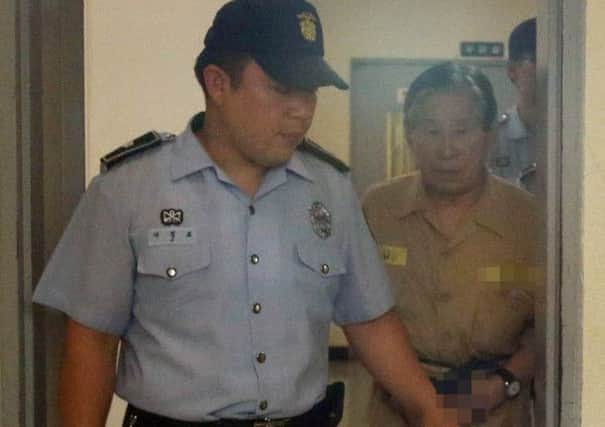South Korea ferry horror bosses’ negligence


Prosecutors said the five were to blame for the ship being unstable due to poorly stowed cargo and a redesign which made it top-heavy. They were also accused of neglecting crew safety training, on which the company spent less than $2 (£1.20) last year.
The defendants maintain that the cause of the MV Sewol ferry capsize remains unknown.
Advertisement
Hide AdAdvertisement
Hide AdThey had been expected to enter verbal pleas at a preliminary hearing yesterday at Gwangju district court, but their lawyers said they needed more time and would submit written pleas at a later date.
Another court hearing is scheduled for all five to reappear in three weeks’ time.
The chief executive and four management figures at the operator, Chonghaejin Marine Company, faced a less hostile reception when they arrived at court yesterday than had the 15 crew members charged with negligence last week, when family members of victims of the tragedy heckled and screamed at them throughout the hearing.
When Judge Lim Joung-youb asked if there were relatives of the victims present in court yesterday, no hands were raised.
Prosecutors indicted the company officials for alleged professional negligence and violating laws regulating safety at sea.
The Sewol, a 6,825-tonne car ferry purchased in Japan for 800 million yen (£4.6m) in 2012, was redesigned to add cabins and create an exhibition room after its purchase, according to the indictment.
The ship became top-heavy due to the redesign. As a result, the Korean Register of Shipping approved the ship as seaworthy on the condition that it substantially reduced its cargo limit.
Chonghaejin is said to have continued to overload the ferry with cargo even though it knew the redesign made it unstable. By routinely overloading the Sewol, Chonghaejin made an extra $3m (£1.8m) in profit in the past year, according to the indictment.
Advertisement
Hide AdAdvertisement
Hide AdChief executive Kim Han-sik, 71, did not deny the ferry was overloaded and had been redesigned, but said it was questionable whether those factors led to the sinking, according to his lawyer, Kang Seok-won.
Defendant Nam Ho-man, who headed Chonghaejin’s cargo team, never told workers to load as much cargo as possible, did not know the ferry’s cargo limit or how much cargo was loaded on the day of the accident, said his lawyer, Kim Jun-seong.
Meanwhile, prosecutor Park Jae-eok said the five defendants neglected passenger safety to boost profits and must be held responsible for the tragedy.
Chief executive Kim encouraged managers at a weekly gathering to meet cargo targets even as he sought to sell the ship because of the instability caused by the redesign, mounting losses and rising costs, Mr Park alleged.
Employees who failed to hit the firm’s cargo target were given a warning at the same weekly meetings. The prosecutor also said that the employees at Chonghaejin were responsible for the captain and crew abandoning the sinking ship and their failure to protect passengers because they did not oversee sailors’ emergency training and spent only $2 on training last year.
That money covered the fee for issuing a certificate to a sailor who received training elsewhere, Mr Park said.
The Sewol sinking has caused widespread grief and fury in South Korea and has prompted a major reassessment of attitudes to safety, so often disregarded in the pursuit of economic growth.
President Park Geun-hye has apologised and reshuffled her cabinet in response to public criticism of her ministers.
Advertisement
Hide AdAdvertisement
Hide AdAll but one of 15 crew members responsible for navigating the ferry have pleaded not guilty to charges linked to their alleged failure to protect passengers, who were mostly high school students on a school trip.
The crew members, including the captain, said through their lawyers that their employer was responsible for the ship’s sinking because sailors had no control over the cargo. They said the coastguard was responsible for rescuing the passengers.
A total of 292 bodies have been recovered and 12 people are still missing from the sinking, one of South Korea’s worst peacetime disasters.